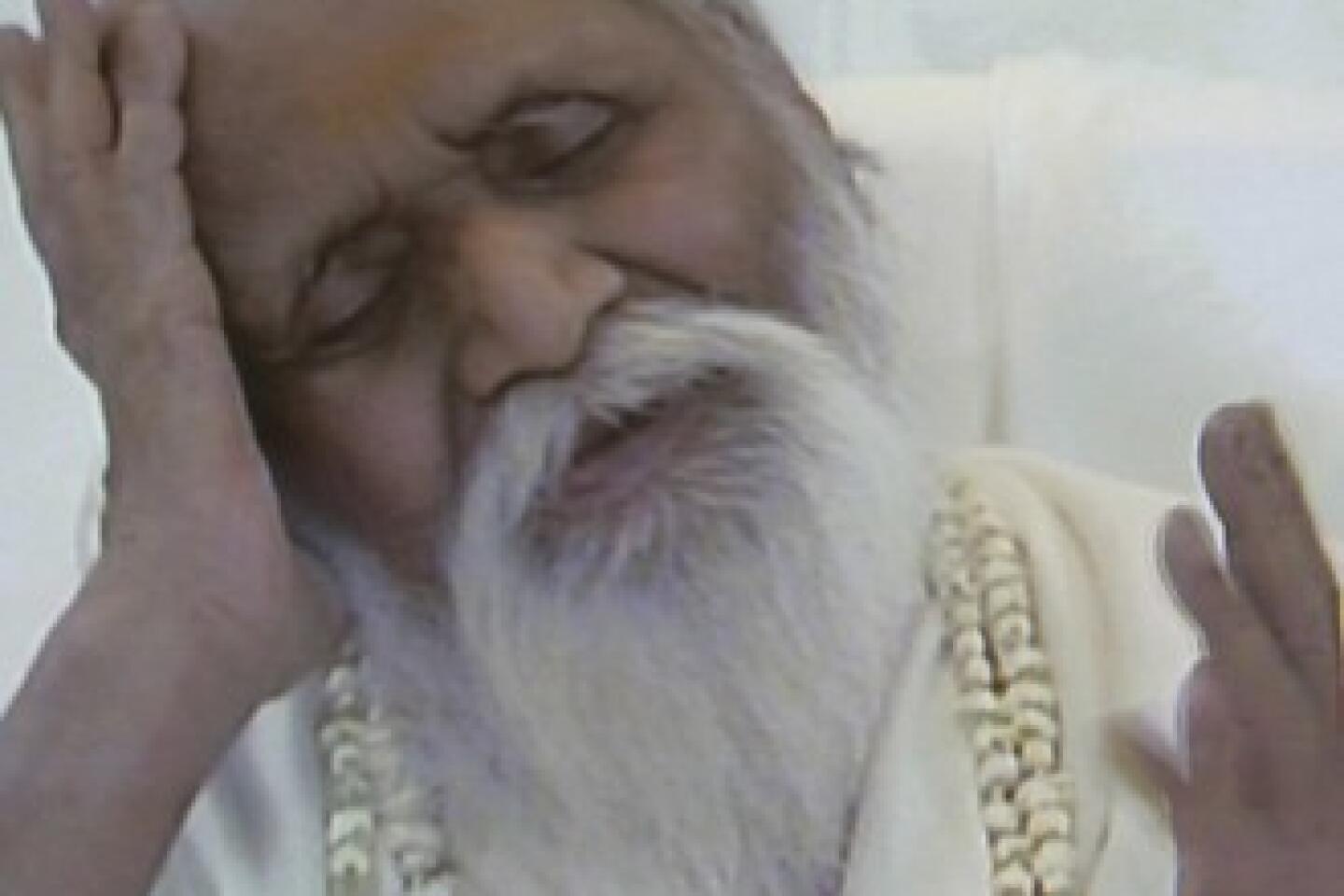Maharishi Mahesh Yogi; founded Transcendental Meditation movement
- Share via
Maharishi Mahesh Yogi, the founder of the Transcendental Meditation movement, who taught the Beatles to meditate, made “mantra” a household word in the 1970s and built a multimillion-dollar empire on a promise of inner harmony and world peace, died Tuesday in Vlodrop, the Netherlands. He was believed to have been 91.
Bob Roth, a spokesman for the Transcendental Meditation organization, said the Maharishi died peacefully of natural causes at his private residence in Vlodrop, a village about 120 miles south of Amsterdam where he moved his headquarters in 1990.
John Hegelin, the director of the TM organization in the United States, told The Times on Tuesday that the Maharishi had a transformative effect on Western society.
“He brought meditation to the West. He encouraged scientific research on it and made meditation mainstream,” said Hegelin, who is among 300 world leaders of the movement who have been meeting in Vlodrop since last month.
In Fairfield, Iowa, a town of 9,700 where the Maharishi University of Management is located and where close to 3,000 residents practice TM daily, Mayor Ed Malloy credited the guru with changing “the perception that meditation was something that someone did to renounce the world. He said that meditation could be added to an active lifestyle and enhance all elements of life.”
Meditation, Malloy said Tuesday, “is taken for granted now, but back in the late 1950s and early ‘60s, he was the one who turned that perception around.”
Known as the “giggling guru” for his high-pitched laugh, the Maharishi headed the TM organization for 50 years until Jan. 11, when he issued a farewell message. His devotees around the world were stirred by his announcement and believed that he was preparing for his death. TM officials said he was retiring to concentrate on silence and studying the ancient Indian texts that had inspired his spiritual teachings.
The diminutive Indian philosopher, who brought his brand of Eastern mysticism to the West in the late 1950s, had attained a cult-like following by the end of the 1960s, when his message of peace resonated with a counterculture in bloom. His most famous followers were the Beatles, who spent a month at his ashram in India in 1968 and wrote some of their more popular songs there.
By the mid-1970s, TM had an estimated 600,000 practitioners, including actresses Shirley MacLaine and Mia Farrow; football star Joe Namath and pop singer Donovan. TM how-to books rose on bestseller lists, close behind the decade’s iconic blockbuster, “The Joy of Sex.”
Before long, the Maharishi had established a political party, a gold-domed university in Fairfield and a network of several hundred TM centers around the country.
“Transcendental Meditation is the McDonald’s of the meditation business,” bestselling author Adam Smith once wrote of the movement, which claims more than 5 million practitioners in 130 countries.
The guru’s message was appealing in its simplicity: A person could reduce stress and attain happiness by meditating 20 minutes twice a day on a secret Sanskrit word, or mantra.
If sufficient numbers of meditators achieved inner peace, the Maharishi said, they could radiate bliss to the world, which would reduce crime and end wars.
“The philosophy of life is this: Life is not a struggle, not a tension . . . . Life is bliss. It is eternal wisdom, eternal existence,” the Maharishi once said.
Beginning in the 1970s, a number of scientific studies were conducted that showed beneficial physiological effects to TM, including reducing hypertension.
In later years, the Maharishi claimed that advanced practitioners of Transcendental Meditation could defy the laws of physics and fly through the air like Peter Pan -- a feat that would require not only dedication but at least $275 a week for a four-to-eight-week course. Such claims brought a wave of skeptical news stories that portrayed the Indian mystic as the P.T. Barnum of the New Age.
Whether huckster or holy man, the Maharishi intrigued Americans, thousands of whom were introduced to his ideas in 1975 by talk-show host and meditation enthusiast Merv Griffin, who had the guru on his program. Transcendental Meditation was by then a full-blown craze -- “the turn-on of the ‘70s,” a Time magazine cover story proclaimed, and less risky than drug-induced highs. Or, as Kurt Vonnegut, whose wife and daughter were TM followers, wrote in an Esquire magazine article a few years earlier, the TM route to rapture meant “the fuzz can’t bust you.”
The influential guru was born Mahesh Prasad Varma, the son of a local tax official in the Northern Indian state of Uttar Pradesh. Various accounts give the year of his birth as 1911, 1917 or 1918; when he became the Maharishi, he was not inclined to clear up the mystery, saying that age was unimportant.
According to his official biography, he studied physics at Allahabad University and earned a degree in 1942. While in college, he became a student of Swami Brahmananda Saraswati, a major leader of the Hindus who was called Guru Dev, or “divine teacher.” After graduating from college, he trained under Brahmananda until the guru died in 1953.
Following Guru Dev’s death, the Maharishi retreated into the Himalayas for a two-year period of meditation. When he emerged in 1955, he devoted himself to popularizing his master’s form of meditation, which was derived from Advaita Vedanta, a branch of Hindu philosophy.
He called his version of it the Spiritual Development Movement and later the Spiritual Regeneration Movement.
By 1959 he had embarked on a world tour to spread his method of attaining higher consciousness. After establishing a base in London, he moved on to the U.S., where his first stop was San Francisco.
He lectured there for two months before heading to Los Angeles, New York and other points in Europe.
In 1963 he wrote his first major book, “The Science of Being and Art of Living,” a comprehensive introduction to his thought.
Two years later he completed a commentary on the Bhagavad-Gita, one of the principal Vedic texts.
His movement began to gain momentum in 1965, when the Student International Meditation Society was founded and gained thousands of members within a few years.
In 1967, George Harrison took fellow Beatles John Lennon and Paul McCartney to hear the Maharishi lecture in London. Soon the fourth band member, Ringo Starr, joined them in a seminar for British initiates who, for a $35 fee, received their own mantra. (Today the basic course costs $2,500.)
In 1968, the Beatles traveled to the Maharishi’s ashram at Rishikesh in the Himalayas for more intensive study.
There they joined other wisdom-seeking celebrities, including Farrow, Donovan and Mike Love of the Beach Boys.
Out of the Beatles’ Rishikesh experience came songs such as “Across the Universe,” which includes the words “Jai guru deva om,” a phrase said to translate roughly to “I give thanks to Guru Dev,” the Maharishi’s teacher.
Although TM officials discount reports that the legendary foursome became disenchanted with the Maharishi during their visit, Beatles chroniclers have said that the group was dismayed by the guru’s megalomania and doubted his claims of celibacy.
“We made a mistake,” McCartney told an interviewer later. “We thought there was more to him than there was. He’s human. We thought at first that he wasn’t.”
The Maharishi continued to attract followers eager to learn his meditation technique, such as magician Doug Henning, a highly visible TM promoter until his death from liver disease in 2000.
Another prominent supporter is filmmaker David Lynch, who has been raising money to help the Maharishi build “peace palaces” around the world.
Lynch explained the power of Transcendental Meditation in a 2006 memoir called “Catching the Big Fish:” “Inside every human being is an ocean of pure, vibrant consciousness. When you ‘transcend’ in Transcendental Meditation, you dive down into that ocean of pure consciousness. You splash into it. And it’s bliss.”
Among the earliest skeptics was Vonnegut, who met the Maharishi in Cambridge, Mass., in 1968. He described a beneficial effect on his TM-practicing wife and daughter -- “Nothing pisses them off anymore. They glow like bass drums with lights inside” -- but in the end took a dim view of the movement. TM, he wrote, was “a very good religion for people who, in troubled times, don’t want any trouble.”
Vonnegut examined the Maharishi’s operation before the spiritual leader announced an advanced form of the meditation, called yogic flying, in which practitioners purportedly could levitate themselves.
The Maharishi refused to allow public demonstrations of the flying, which only hardened doubters, but he insisted that when performed by a critical mass of the population it would reduce tensions in the world and lead to peace.
Later, critics labeled TM a cult and likened its meditation techniques to hypnotism.
In 1986, Robert Kropinski, a former TM follower, sued the Maharishi University in Fairfield for $9 million, charging fraud, neglect and emotional damage.
He also alleged that university officials had used “fear and intimidation” to try to prevent him from leaving the school. A jury awarded him $138,000.
Networks of disaffected TM practitioners began to appear, offering similar stories. Many former TM employees claimed that they were ousted because they refused to adhere to the Maharishi’s strict rules, which forbade teaching other forms of meditation.
Among those who broke away was Deepak Chopra, who had been one of the Maharishi’s top assistants before he launched his own career as a bestselling author and lecturer on natural healing.
Even some former followers continued to admire the Maharishi, however.
“He was very charismatic. He had an amazing aura,” said Susan Shumsky, who worked on the Maharishi’s personal staff for several years in the 1970s, until she left the organization. She’s now a minister in New York. “Whenever you were with him you felt you were in a timeless place and that you were being lifted to a higher consciousness. Some skeptics might say it was all hypnotism. I believe there are people with higher consciousness, and I believe he was one of them.”
He will be succeeded by Maharaja Nader Raam, a Lebanese doctor who studied with the Maharishi for 25 years.
The Maharishi’s body will be returned to India after a memorial ceremony in Vlodrop on Thursday, Roth said.
More to Read
Sign up for Essential California
The most important California stories and recommendations in your inbox every morning.
You may occasionally receive promotional content from the Los Angeles Times.












